
Joseph Henry Simon was an American comic book writer, artist, editor, and publisher. Simon created or co-created many important characters in the 1930s–1940s Golden Age of Comic Books and served as the first editor of Timely Comics, the company that would evolve into Marvel Comics.

The Fly is a superhero appearing in American comic books published by Red Circle Comics. He was created by Joe Simon as part of Archie's "Archie Adventure Series" and later camped up as part of the company's Mighty Comics line. He first appeared in The Double Life of Private Strong #1 ; however, his origin story and first "full-length" appearance were in Adventures of the Fly #1.

All Star Comics is an American comic book series from All-American Publications, one of three companies that merged with National Periodical Publications to form the modern-day DC Comics. While the series' cover-logo trademark reads All Star Comics, its copyrighted title as indicated by postal indicia is All-Star Comics, with a hyphen. With the exception of the first two issues, All Star Comics told stories about the adventures of the Justice Society of America, the first team of superheroes. It also introduced Wonder Woman.

The House of Secrets is the name of several mystery, fantasy, and horror comics anthologies published by DC Comics. It is notable for being the title that introduced the character the Swamp Thing. It had a companion series titled The House of Mystery.

Alexander Toth was an American cartoonist active from the 1940s through the 1980s. Toth's work began in the American comic book industry, but he is also known for his animation designs for Hanna-Barbera throughout the 1960s and 1970s. His work included Super Friends, Fantastic Four, Space Ghost, Sealab 2020, The Herculoids and Birdman. Toth's work has been resurrected in the late-night, adult-themed spin-offs on Cartoon Network’s late night sister channel Adult Swim: Space Ghost Coast to Coast, Sealab 2021 and Harvey Birdman, Attorney at Law.
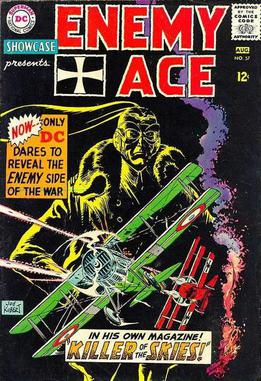
Enemy Ace is a DC Comics property about the adventures of a skilled but troubled German anti-hero and flying ace in World War I and World War II, Hans von Hammer, known to the world as "The Hammer of Hell". Debuting in 1965, the comic was written by Robert Kanigher and drawn by Joe Kubert and the character has been revived several times since by other writers and artists.
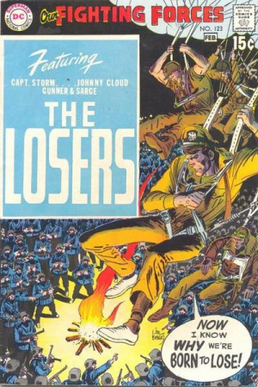
The Losers is the name of a war comic book feature published by DC Comics. The name was later given to a reimagined comic book series for DC's Vertigo imprint.
Robert Kanigher was an American comic book writer and editor whose career spanned five decades. He was involved with the Wonder Woman franchise for over twenty years, taking over the scripting from creator William Moulton Marston. In addition, Kanigher spent many years in charge of DC Comics's war titles and created the character Sgt. Rock. Kanigher scripted what is considered the first Silver Age comic book story, "Mystery of the Human Thunderbolt!", which introduced the Barry Allen version of the Flash in Showcase #4.
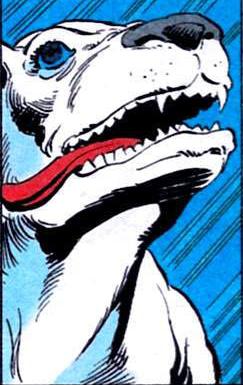
Rex the Wonder Dog is a fictional superhero dog in the DC Comics universe. Created in 1952 by Robert Kanigher of Wonder Woman fame and artist Alex Toth, Rex has sometimes been compared to Superman's dog Krypto, who was created three years later. While the two canine crime fighters do share some similarities, they are decidedly different.

Star Spangled War Stories is the title of a comics anthology published by DC Comics that featured war-themed characters and stories. Among the features published in this series were writer-editor Robert Kanigher and artist Jerry Grandenetti's "Mademoiselle Marie", about a World War II French Resistance fighter, debuting in #84 ; The War that Time Forgot featuring the Suicide Squad, the "Enemy Ace" and the "Unknown Soldier".

G.I. Combat is an American comics anthology featuring war stories. It was published from 1952 until 1956 by Quality Comics, followed by DC Comics until its final issue in 1987. In 2012 it was briefly revived.
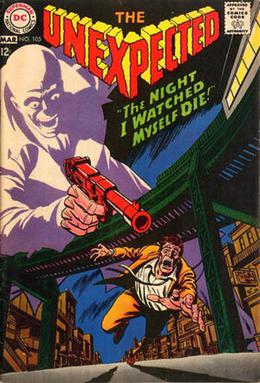
The Unexpected is a fantasy-horror comics anthology series, a continuation of Tales of the Unexpected, published by DC Comics. The Unexpected ran 118 issues, from #105 to #222. As a result of the so-called DC Implosion of late 1978, beginning in 1979 The Unexpected absorbed the other DC horror titles House of Secrets, The Witching Hour, and Doorway to Nightmare into its pages. Horror hosts featured in The Unexpected included The Mad Mod Witch, Judge Gallows, Abel, and the Witches Three.
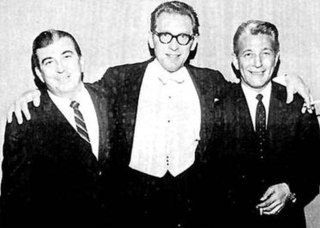
Robert Bernstein, sometimes credited as R. Berns, was an American comic book writer, playwright and concert impresario, notable as the founder of the Island Concert Hall recital series which ran for 15 years on Long Island.
Samuel Joseph Glanzman was an American comics artist and memoirist. Glanzman is best known for his Charlton Comics series Hercules, about the mythological Greek demigod; his autobiographical war stories about his service aboard the U.S.S. Stevens for DC Comics and Marvel Comics; and the Charlton Comics Fightin' Army feature "The Lonely War of Willy Schultz", a Vietnam War-era serial about a German-American U.S. Army captain during World War II.

Our Army at War is an American comic book anthology published by DC Comics that featured war-themed stories and featured the first appearances of Sgt. Rock and Enemy Ace. The series was published from August 1952 to February 1977, then was renamed Sgt. Rock in March 1977, continuing the numbering sequence of Our Army at War.
Charles J. "Jerry" Grandenetti was an American comic book artist and advertising art director, best known for his work with writer-artist Will Eisner on the celebrated comics feature "The Spirit", and for his decade-and-a-half run on many DC Comics war series. He also co-created the DC comic book Prez with Joe Simon.
Mademoiselle Marie is the name of two fictional characters appearing in comic books published by DC Comics. She first appeared in Star Spangled War Stories #84, and was created by Robert Kanigher and Jerry Grandenetti. She was based in part on several actual members of the French resistance, most notably Simone Segouin.

Men of War is the name of several American comic book series published by DC Comics. For the most part, the series was a war comics anthology featuring fictional stories about the American military during World War II.
All-Out War is an American war comics anthology series published by DC Comics from 1979 to 1980. It primarily featured characters created by writer Robert Kanigher with the Viking Commando being the lead feature.

Manhunter is a superhero and later anti-hero appearing in comic books published by DC Comics. He was the first published hero referred to as Manhunter within the DC Universe. Originally a plainclothes amateur detective character, Kirk was called "manhunter" only in the title of his stories, a slang term for someone who tracks down fugitives and criminals. He then dons a red and blue costume and officially adopts "Manhunter" as an alias in 1942. The character's stories ended in 1944. Paul Kirk was then revived in 1973 in a globe-trotting conspiracy thriller storyline told through a series of back-up published in Detective Comics vol. 1 #437-443. Reintroducing Kirk as a more ruthless and now lethal hero working against a villainous group called the Council, the story gave him a new costume, new weapons, and a superhuman healing ability. Though the 1973 story became a critical success with readers, Kirk dies at the end of it and was not resurrected by DC Comics. Instead, the Manhunter name has passed on to other heroes.















